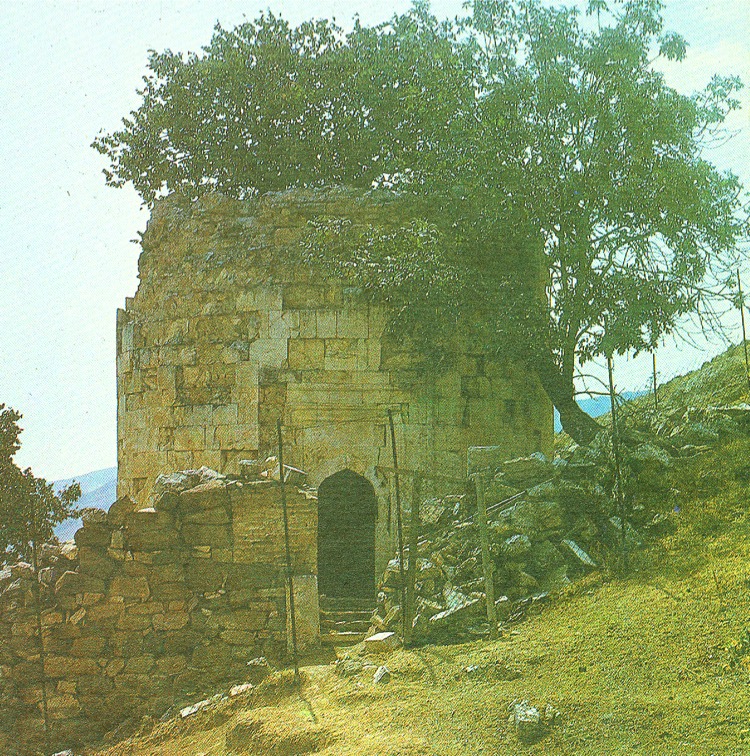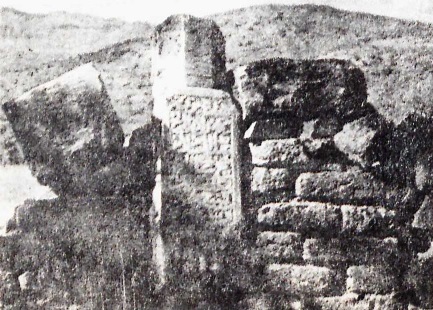
The mausoleum Shikh Baba is located in the cemetery of Shykhlar village in Jabrayil region of Azerbaijan on the old trade and caravan route of the Silk Road. Among the local residents, the monument is known as the “Tomb of Shikh Baba” .
[Karabakh: history in the context of the conflict\\Meshadikhanum Neymatova. Epigraphic monuments of Karabakh. 2014, p. 145]
[M. Neymat. Pirs (sanctuaries) of Azerbaijan. 1992, p. 16]
[M. Neymat. The corpus of epigraphic monuments of Azerbaijan. Volume V. 2011, p. 15;64;223]
According to Azerbaijani epigraphist Meshadikhanum Neymatova, the mausoleum dates back to the XIV century.
[M. Neymat. The corpus of epigraphic monuments of Azerbaijan. Volume V. 2011, p. 15-16]
[The object of the Armenian terror – the monuments of the material culture of the Azerbaijani people. 2007, p. 19]
According to the popular legend, the sheikh buried in the mausoleum was a representative of the family of Sheikh Vali ad-Din (died in 1070) and belonged to Sufi order “Qadiriyah”. He moved to the village of Dagh Tumas of the Jabrayil region at the end of the XVI century and continued to spread the teachings of the sheikh.
The beginning of activity of the order in Azerbaijan dates presumably from the XIII century.
In the book of 2007” The Object of Armenian Terror – monuments of the material culture of the Azerbaijani people”, it is noted that according to the paleography of inscriptions, carving technique and artistic shaping of the tombstone stones located inside and around the mausoleum, the time of the activity of Qadiriyah khaneghah dates back to the XIII-XIV centuries.
In the book of Meshadikhanum Neymatova “Pirs of Azerbaijan” (1992), there is indicated the date of the XII-XIII centuries.
At the same time, Meshadikhanum Neymatova noted the following:
“We had no information about the existence of the center of this order in Azerbaijan before the discovery of this building.”
[Karabakh: history in the context of the conflict\\Meshadikhanum Neymatova. Epigraphic monuments of Karabakh. 2014, p. 146]
[M. Neymat. Pirs (santuaries) of Azerbaijan. 1992, p. 19]
[The object of the Armenian terror – the monuments of the material culture of the Azerbaijani people. 2007, p. 17]
The mausoleum was built of stone. From the inside and outside, it has a mostly circular shape. The round dome of the monument collapsed, and the mausoleum was overgrown with two junipers inside and outside. According to the remaining parts on which the dome rested, the mausoleum had a double cover: a dome inside, and a tent outside.
[M. Neymat. Pirs (sanctuaries) of Azerbaijan. 1992, p. 16]
[Karabakh: history in the context of the conflict\\Meshadikhanum Neymatova. Epigraphic monuments of Karabakh. 2014, p. 146]
Meshadikhanum Neymatov in “Pirs of Azerbaijan” (1991) notes:
“In the center of the monument there is the grave of the sheikh. Stones that fell from the dome and other various memorial monuments have been accumulated on it. The search for his written monument among the stone piles did not yield results.” However, one of the tombstones found among the stone piles on the sheikh’s grave had the inscription – “This is the grave of Sheikh Akbar”. This tombstone inscription is the grave of one of the followers of the sheikh.
[M. Neymat. Pirs (sanctuaries) of Azerbaijan. 1992, p. 16-18]
[Karabakh: history in the context of the conflict\\Meshadikhanum Neymatova. Epigraphic monuments of Karabakh. 2014, p. 145 – 146]
[M. Neymat. The corpus of epigraphic monuments of Azerbaijan. Volume V. 2011, p. 64;223]
Once the mausoleum was surrounded by a square fence of baked bricks from which only a small fragment of its entrance part has survived at the moment. Behind the fence there is a huge medieval necropolis, the territory of which is still used by local residents as a cemetery.
[M. Neymat. Pirs (sanctuaries) of Azerbaijan. 1992, p. 16-18]
[M. Neymat. The corpus of epigraphic monuments of Azerbaijan. Volume V. 2011, pp. 15;28;66;223]
[Karabakh: history in the context of the conflict\\Meshadikhanum Neymatova. Epigraphic monuments of Karabakh. 2014, p. 145 – 147]
[The object of the Armenian terror – the monuments of the material culture of the Azerbaijani people. 2007, p. 19]
There are tombstone steles inside the mausoleum and around it placed in a scattered form. They belong to his followers: Abd ar-Rahman b. Sheikh Hussein, Sheikh Muhiy ad-Din, Sheikh Akbar, etc. Due to the paleography of the inscriptions, the carving technique and the decoration of the steles, Meshadikhanum Neymatova attributes them to the XIII-XIV centuries.
The tombstones located in the necropolis date from the XIV – early XX century. Most of the monuments are covered with earth.
[Karabakh: history in the context of the conflict\\Meshadikhanum Neymatova. Epigraphic monuments of Karabakh. 2014, p. 146]
There are no inscriptions above the lancet arch of the doorway. There is a tombstone at the entrance to the mausoleum on the threshold. It contains an Arabic inscription in naskh’s handwriting with elements of suls:
“The venerated month of Rajab, the year of seven hundred and seven” (27.12. 1307-26.1.1308). (A similar text in identical form is available on the tombstone at the mausoleum, behind the fence: “The month of Rajab, the year of seven hundred and seven”).
In the book “Pirs (sanctuaries) of Azerbaijan” noted the following: “It can be assumed that the monument belongs to a man buried at the threshold of the sheikh’s tomb. Since there is no name on it, it can be argued that a woman is buried in this place. The stone seems to have been placed here during the construction of this building.”
[M. Neymat. Pirs (sanctuaries) of Azerbaijan. 1992, p. 16-17]
[Karabakh: history in the context of the conflict\\Meshadikhanum Neymatova. Epigraphic monuments of Karabakh. 2014, p. 146]

In a niche near the fence, on the side of the courtyard located opposite the entrance to the mausoleum, there is a marble tombstone with an Arabic inscription in naskh’s handwriting with elements of suls: “He drank from the spring of knowledge. This is the grave of the noble (in the book “Pirs (sanctuaries) of Azerbaijan” it is noted as merciful) Sheikhzadeh Sheikh Abd as-Salam bin (i.e., son) Sheikh Giyas ad-Din, died on 20 Ramadan H. 759 (08.27.1358).
[Karabakh: history in the context of the conflict\\Meshadikhanum Neymatova. Epigraphic monuments of Karabakh. 2014, p. 146]
[M. Neymat. Pirs (sanctuaries) of Azerbaijan. 1992, p. 17]
[The object of the Armenian terror – the monuments of the material culture of the Azerbaijani people. 2007, p. 19]
During the period of independence of the Republic of Azerbaijan restoration work was not carried out, as in 1993 Jabrayil region was occupied by Armenian armed groups, after which the mausoleum and the surrounding graves were vandalized.




